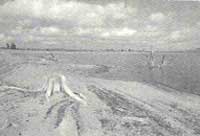As deadly as thermal power
As deadly as thermal power

RECENT Canadian studies suggest that hydroelectric power generation may, in some cases, be a major source of greenhouse gases, such as methane and carbon dioxide, and so be as polluting as thermal power generation (Ambio, Vol 22, No 4).
The gases are produced, explain John W M Rudd of the Freshwater Institute in Manitoba and his colleagues, by bacterial decomposition of forests recently flooded by dam reservoirs. In Canada, trees are usually not removed prior to flooding.
A study on the Notigi reservoir in the Canadian state of Manitoba reveals that the greater the area flooded, the greater are likely to be the greenhouse gas emissions.
Recent observations at the La Grande II-Boyd-Sakami Reservoir complex in northern Quebec also reveal that carbon dioxide concentration at the sampling sites on the reservoir was two to three times its normal atmospheric concentration. On the other hand, researchers found that older lakes like Nipignon and Superior were actually absorbing carbon dioxide from the atmosphere during the ice-free season.
Scientists haven't yet found out how long after flooding, a reservoir will continue to emit greenhouse gases. They say there will be an initial period of rapid decomposition of the most easily degradable organic matter such as leaves, with a high rate of greenhouse gas emission, followed by a slower rotting of small branches and peat. When the decomposition is complete, the reservoir will behave like a natural lake.
The scientists discovered the rates of emission of greenhouse gases by hydroelectric generation for each unit of electricity produced vary with the extent and type of landscape flooded. They found a reservoir with a high ratio of flooded area to the electricity produced generates more greenhouse gases than one with a low ratio. And, the quantity of greenhouse gases produced by high ratio reservoirs is similar to that produced by coal-fired power plants.







